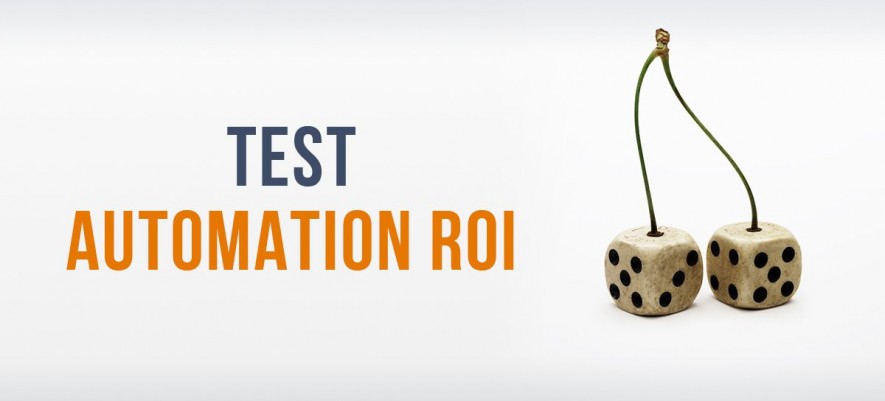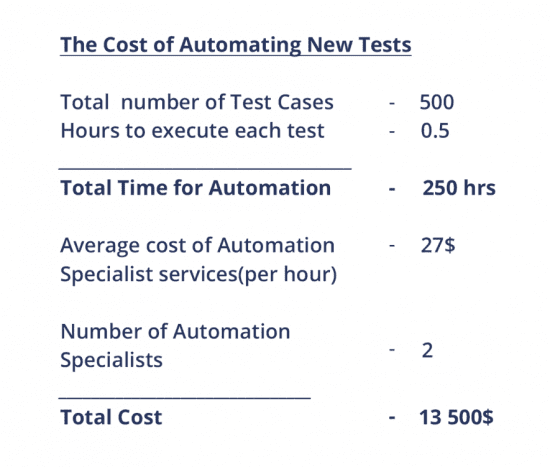- QATestLab Blog >
- QA for Business >
- Calculating the Return on Investment (ROI) of Test Automation
Calculating the Return on Investment (ROI) of Test Automation

Still can’t decide whether implementing automated tests would be beneficial for your project in the long run? Learn best practices for calculating the ROI of test automation.
Calculating the Return on Investment (ROI) of Test Automation
Return on investment (ROI) is a financial measure for calculating investment profitability. The formula is as follows:

ROI can be calculated both for the whole duration of business activity or for a particular stage. Let’s look at the example: this month you spent 500$ on the advertisement of your online shop on social networks. During the same month, you got 200 new clients who made purchases in the total amount of 1100$. To calculate ROI, we need to take away the cost of the advertisement from income, and then divide the resulting value by the number of advertising costs:

As a result, you get a 120% return on investments for a period of one month.
ROI in Test Automation
Test automation at projects helps to meet the increasing demand for fast releases and bug-free software. Apart from speed and quality, it also reduces costs, allocated for testing. Like any other type of investment, the effectiveness of test automation is defined via the calculation of ROI. The general equation for this process is as follows:

The main question that appears is “How to detect the income and investments (loss)?” We consulted a QATestLab specialist on test automation, and here is what he says:
“It is rather challenging to calculate ROI for test automation before the start of a project as you can’t define the exact number of tests that will be automated. What you can calculate is the money spent on getting the license for automation tools, the approximate time that will be spent on automation, and the rates for specialists’ services.”

Main purposes of test automation
The demands for test automation will vary according to the specifics of a particular product, but its general goals are the following:
- increasing the capacity of a testing team;
- minimizing the time spent on testing;
- extension of testing coverage;
- minimizing human involvement.
Like any other kind of work optimization, automation testing requires investments both financial and non-material. Anyway, these investments should bring profit, otherwise, they will be useless. ROI will help you to determine if test automation is the right solution for your project, but it is very important to consider the most frequent mistakes that hinder the correct ROI calculation.
Main pitfalls in calculating ROI for test automation
We have gathered the most common mistakes that can be made in the process of ROI definition:
Comparing losses and gains of automation vs manual testing. Automation cannot cover all types of tests, and there always will be scenarios that require manual checking. The scope of these testing methods is not equal as well as expenses on them, that is why calculation of ROI, in terms of their comparison, is irrational.
No synchronization of automation tools pool with managerial capacities. To present a successful scenario of automation testing, it is not enough just to know the tools and methods. The process that requires a lot of time and human resources is studying a particular product and organizing a team to work on a project. If you don’t consider these investments, the calculation of ROI won’t be accurate.
Not considering the maintenance process. The implementation of test automation is only half the battle. Tests should be constantly maintained and updated, especially after adding new features to the product. The automation suite will grow in this case and require continuous monitoring and support.
Not calculating ROI for time periods. Speaking about test automation, it is more effective to define return on investment for periods of time:
“If a team is organized according to Scrum methodology, it will be correct to calculate ROI for these two- or three-week sprints when you see how fast the team accomplishes the set tasks and have the scope of performed work,” – explains QATestlab test automation engineer.
Final Word on ROI for Test Automation
Сalculation of ROI is quite clear if conducted according to the formula, but as usual, there is one catch: it is clear for fixed costs. In the case of test automation, it is hard to determine the exact ROI as it hasn’t got fixed expenses, and clear gains cannot be predicted before the start of a project. This ratio will be approximate and will not give the exact numbers. On the other hand, if you consider all the tips given above and apply them to your particular project, you will understand the general principles of calculating ROI for test automation and check if it works for you.
Learn more from QATestLab
Related Posts:
- How automation testing can help your software development process
- 6 Steps To Automate Your Testing Process
- Test Automation 101: Should The Programming Languages of Your Software and Autotests Match?








No Comments Yet!
You can be the one to start a conversation.